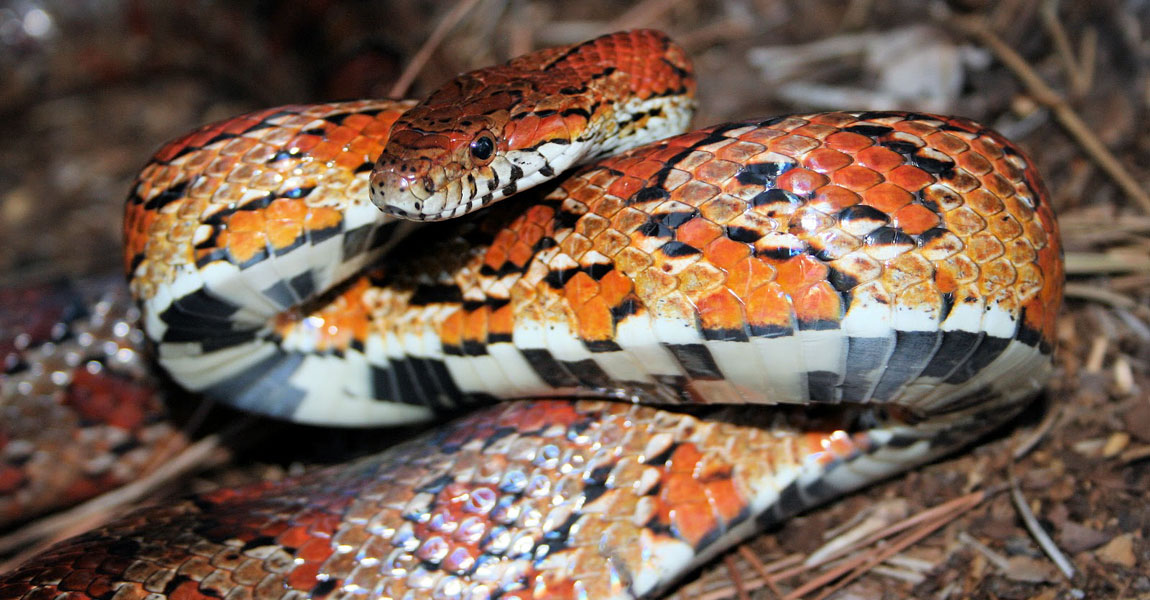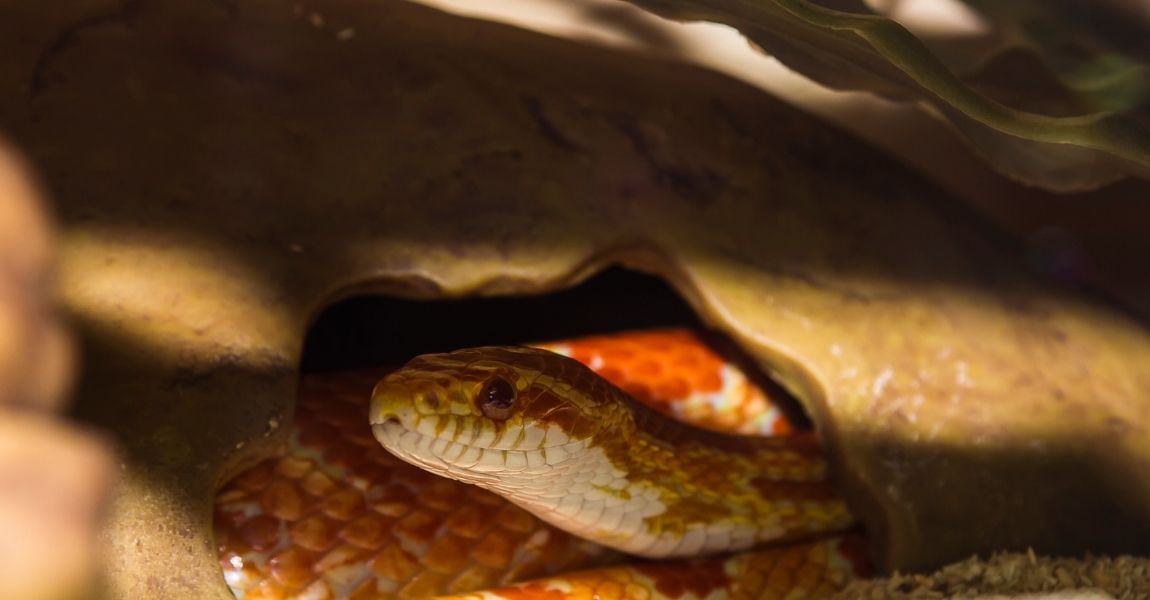Pros of Having a Corn Snake
1. Corn Snakes are Very Docile
Corn Snakes are docile snakes who don’t have temperamental tendencies.
Corn Snakes often won’t strike out and can tolerate human attention for long periods of time. So, if you are a snake fanatic and enjoy interacting with your snake, a Corn Snake would make a good pet.
With Corn Snakes, you don’t have to worry as much about being bitten. It takes a lot to provoke a Corn Snake to bite you, and with at least weekly handling, your Corn Snake will quickly become comfortable with you handling it frequently.
Just like any other snake, Corn Snakes can become irritated or afraid and strike out at you. If this happens, you are not likely to get any serious injuries, though the bite may be a little painful.
If you do get bitten, place the snake back in its habitat and give it time to calm down. Meanwhile, clean your wound to prevent infection. If you want to learn more about what to do when a snake bites you, click this link to read an article we wrote all about snake bites, including what to do when your bit and other facts about snake bites.
2. Corn Snakes Stay Small
Another pro that I saw frequently listed on various snake websites was the small size of a Corn Snake. Corn Snakes only grow to be around three to six feet in length. Like human height, this can vary, but three to six feet in length is the typical size of a Corn Snake.Most snake owners consider this an ideal size because of ease of care that comes with smaller snakes. However, Corn Snakes still get big enough to handle in a comfortable matter (you don’t have to worry about mishandling them or squishing them).
A Corn Snake’s small size also means that it doesn’t require a large snake terrarium like some other breeds of snakes. A comfortably sized terrarium would be a 20 gallon glass tank with enough room to place other habitat items such as hide boxes, a water dish, and the substrate. Corn Snakes are small, so be sure to secure the tank to prevent escape.
3. Corn Snakes are Attractive Pets
A Corn Snake’s typical pattern consists of large patches or bands of red-orange ringed with a band of black followed by smaller dull yellow bands. However, Corn Snakes can come in a variety of morphs (colors and patterns) that make it extremely attractive. There are typically three morph types to choose from: color variation, pattern variation, and compound morphs.Color morphs are exactly what they sound like, Corn Snakes with varying colors ranging from vibrant reds and golds to snow white. While a few of these colors are naturally occurring in the wild, often, you will have to go to a breeder who has taken care to produce specific color morphs.
Pattern morphs may also have a variety of colors, but often, it is a varying of the typical Corn Snake pattern that is found in these morphs. Some of the pattern variations can include motley, diffusion, and stripe.
Compound morphs are a mixture of color and pattern morphs and can come in thousands of different variations.
4. Corn Snakes Tolerate Being Held for Long Periods of Time
Corn Snakes are great snakes if you like being able to hold your snake instead of just looking at them through the glass of their terrarium. Their docile temper makes them easy to handle, as long as you are handling them properly. However, just like with all other snakes, this handling trust must be built up over time.When you bring your new Corn Snake home, it might not be used to being handled and not feel comfortable with you picking it up. Don’t worry. As I mentioned above, with time, you can help your snake feel comfortable with being handled. This is especially true with young Corn Snakes who are newly hatched.
Baby Corn Snakes often don’t like being handled. If you start off by letting them get adjusted to their new habitat for a few days after bringing them home, this will prevent your Corn Snake from lashing out at you when you reach in the habitat to try handling it.
After you’ve given your snake time to adjust (this applies to a baby or adult Corn Snakes), start handling your snake for periods of ten to fifteen minutes at a time. You can do this at several points throughout the day, but just make sure that your snake doesn’t seem to be overwhelmed or frightened.
In order successfully create a handling trust between you and your Corn Snake, you need to keep this up for a couple of weeks. Don’t ever let more than a week go by without handling your snake, or he or she might lose that trust and become skittish again.
5. Corn Snakes Live For a Good Few Years
Unlike hamsters or other small pets, Corn Snakes can live to be upwards of six to eight years. Though they don’t live as long as other snakes such as Ball Pythons, who sometimes live to be thirty-years-old, they do live for quite a few years in captivity.On a few occasions, Corn Snakes have been known to live upwards of twelve years. So, if you want a snake that will be your companion for several years, but you are afraid of committing to a snake like a Ball Python, Corn Snakes are ideal for you.
Cons of Having a Corn Snake
1. Corn Snakes are Susceptible to Fungal, Respiratory, and Other Diseases and Infections
Corn Snakes, like all other snake species, are subject to fungal and respiratory diseases that could harm the health and longevity of your snake. You may not want to lose your pet, but you also may not want to invest in medicines or, in extreme cases, a veterinary bill.Fungal infections are something your Corn Snake could potentially contract. These infections can either be superficial or located deep in the skin on your snake.
In order to prevent your snake from contracting any fungal infections, you need to make sure that your Corn Snake’s cage is cleaned thoroughly. This will require a decent amount of effort and attention on your part. Corn Snakes that contract a fungal infection often need to be examined by a vet in order to receive effective treatment.
Corn Snakes can also contract respiratory diseases, leaving them weak. Respiratory infections can also be caused by mouth rot, another common snake ailment. Another common cause of respiratory infection is stress. When a Corn Snake feels stressed out it may cause them to feel sick.
Similarly, poor cage maintenance can also be the cause of a Corn Snake’s respiratory infection. In some cases, a respiratory infection can cause your snake further damage internally. Veterinary attention will be required in most cases of snake illness and can result in medical bills that outweigh the cost of your snake.
There are several other diseases and illnesses that can affect your snake if you are not attentive to your snake’s care. Ultimately, you will need to decide if the bills will be worth your Corn Snake’s life, and that can be a hard choice that no pet owner wants to make.
2. Corn Snakes Require Specific Habitats
Corn Snakes, like most other snakes, require complex habitats. Corn Snakes need specific bedding, temperatures, and humidity levels in order to thrive in their environments. If these needs are not met, your snake can become sick and may even die.Furthermore, all of the items required for furnishing a Corn Snake’s habitat can become pricey. Bedding will need to be replaced at least once a week, and spot-checked regularly. Though you can opt to get some cheaper bedding like newspapers, you will have to deal with the ugliness of the material (if this is something that bothers you).
While Corn Snakes themselves don’t smell, their habitat can become very smelly over time from feces and urine. If you want to avoid bad odor, you must clean your Corn Snake’s cage frequently.
Temperature control can be tricky too. The temperature must remain around 70 to 85 degrees Fahrenheit in order to keep your snake comfortable and happy. Humidity levels are also something you should be aware of when you consider owning a Corn Snake.
Will you be able to control that humidity? If the air gets too dry for a Corn Snake, this can cause your snake to experience problems with shedding. Problems with shedding can then lead to other greater problems which might result in a veterinary bill you have to pay.
3. Corn Snakes Carry Salmonella
Most snakes, including the Corn Snake, can carry Salmonella, a bacteria that can be deadly to humans. Salmonella can be spread through direct contact with your snake, and in some cases, it can also be spread through indirect contact.Salmonella is a bacteria that attacks the bloodstream and intestines in humans. Signs of Salmonella infection can include mild to severe diarrhea, fever, abdominal cramps, and vomiting.
Children and elderly individuals are particularly susceptible to Salmonella and may die from exposure to it. Signs of Salmonella infection may begin to manifest anywhere from one to three days after you are exposed to the bacteria.
It is often recommended by health organizations such as The Department of Health that an individual take many precautions when handling reptiles. It also recommends not to let children five years and younger handle reptiles. So, a Corn Snake, like all other snakes, can put you at risk of a very unpleasant and sometimes fatal bacterial infection.
4. Feeding a Corn Snake can be Tedious
Feeding any snake can involve a lot of preparation on your part. A snake’s food often must be frozen when stored and then and for feedings.Corn Snakes typically eat pre-killed mice, so unless you are ready to kill some mice yourself, you are going to need to purchase pre-killed mice and store them in your freezer. This can be tricky since mice come with their own diseases that you don’t want contaminating anything.
Baby Corn Snakes can only really eat a single newborn pinkie mouse, and you must be careful not to scare the snake when placing the food in its habitat. However, that one meal should keep it satisfied for at least five to seven days.
In some cases, your baby snake might not be interested in eating frozen or thawed pinkie mice, so you will have to feed it a live pinkie mouse in order to get it interested in eating. This can be a hassle if you don’t enjoy tracking down live pinkie mice and then making them a meal for your snake.
On occasions, you might also have to put a little effort into feeding your adult Corn Snake. Since Corn Snakes like to wrap around their prey and constrict them, they might not take to kindly to having frozen food offered.
To combat this, you will need to warm the rodent up to room temperature and then dangle it in front of your Corn Snake. This should entice the snake to strike out at it.
You may also be able to leave the room temperature rodent in the cage, allowing your snake to wrap around it and then eat its meal. Adult Corn Snakes, however, only need to eat one rodent once a week (sometimes even one rodent every two weeks).
Regardless of your Corn Snake’s disposition towards eating, there is a lot of work and care that must be put into a snakes meal. You must use caution when preparing your snake’s meal because mice and snakes both carry bacteria that can be harmful to humans. Don’t prepare your Corn Snake’s meal on a surface you prepare your own food on.
5. You Can’t Play with a Corn Snake Like Other Pets
Unlike other pets, snakes require a lot of attention and don’t do much to contribute to the owner-pet relationship. Dogs, for example, are often energetic and can engage in play time and show affection to their owners. Typically, a Corn snake will not show affection for its owner and cannot engage in games.However, this may appeal to some potential pet owners who are looking for a pet but not wanting to commit to a walking or playtime routine. Corn Snakes, however, like to be held (as long as they are adjusted properly to human contact) and don’t often bite their owners.
Corn Snakes, unlike dogs or cats, cannot be taught to respond to their name or do any tricks. So, if you are looking for an animal you can train and bond with, a Corn Snake is not your best option.
Source: EmboraPets.com




